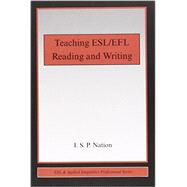
Note: Supplemental materials are not guaranteed with Rental or Used book purchases.
Purchase Benefits
What is included with this book?
| Table of Contents | |
| Learning to read in another language 1 | |
| Learning to read in the first language | |
| Learning to read in another language Principles for teaching reading | |
| Learning to recognise and spell words | |
| Prerequisites for formal reading instruction | |
| Phonics and the alphabetic principle | |
| The role of phonics in a reading programme Spelling: productive phonics | |
| Learning to spell Designing a focused spelling programme | |
| Intensive reading Focuses in intensive reading | |
| Features of a good reading exercise Are comprehension questions good reading exercises? | |
| Comprehension of the text | |
| The focus of comprehension questions Grammar features in the text | |
| Cohesive devices Strategy development Standardized reading procedures Handling the exercises | |
| The role of teaching exercises | |
| Extensive reading Understand the goals and limitations of extensive reading | |
| Find your learners= present vocabulary level | |
| Provide plenty of interesting and appropriate reading texts Set, encourage and monitor large quantities of extensive reading | |
| Support and supplement extensive reading with language focused learning and fluency development | |
| Help learners move systematically through the graded reader levels | |
| Simplified and unsimplified texts | |
| The extensive reading programme | |
| Reading faster | |
| The nature and limits of reading speed | |
| The nature of fluency development | |
| The nature of fluency development activities | |
| Increasing oral reading speed | |
| Increasing careful silent reading speed | |
| Increasing silent expeditious reading speed | |
| Frequently asked questions about reading speed | |
| Assessing reading Motivating Measuring achievement | |
| Diagnosing problems Measuring reading proficiency | |
| Issues in making and using comprehension tests | |
| Guiding writing Principles for teaching writing | |
| Designing tasks Experience tasks Bringing tasks within the learners' experience | |
| Making sure learners have the experience to do a task | |
| Shared tasks Guided tasks | |
| Independent tasks Using the four kinds of tasks | |
| The writing process | |
| The parts of a writing programme Meaning-focused writing | |
| The parts of the writing process | |
| Considering the goals of the writer and model of the reader | |
| Gathering ideas Ideas to text Editing Reviewing | |
| Diagnosing control of the parts of the writing process | |
| Diagnosing from the written product | |
| Topic types The topic type hypothesis | |
| Topic types and writing Topic types and reading | |
| Limitations of the topic type approach | |
| Responding to written work Motivating | |
| Improving the quality of writing | |
| Measuring proficiency in writing | |
| Spelling correspondences | |
| Conjunction relationships | |
| References | |
| Table of Contents provided by Publisher. All Rights Reserved. |
The New copy of this book will include any supplemental materials advertised. Please check the title of the book to determine if it should include any access cards, study guides, lab manuals, CDs, etc.
The Used, Rental and eBook copies of this book are not guaranteed to include any supplemental materials. Typically, only the book itself is included. This is true even if the title states it includes any access cards, study guides, lab manuals, CDs, etc.